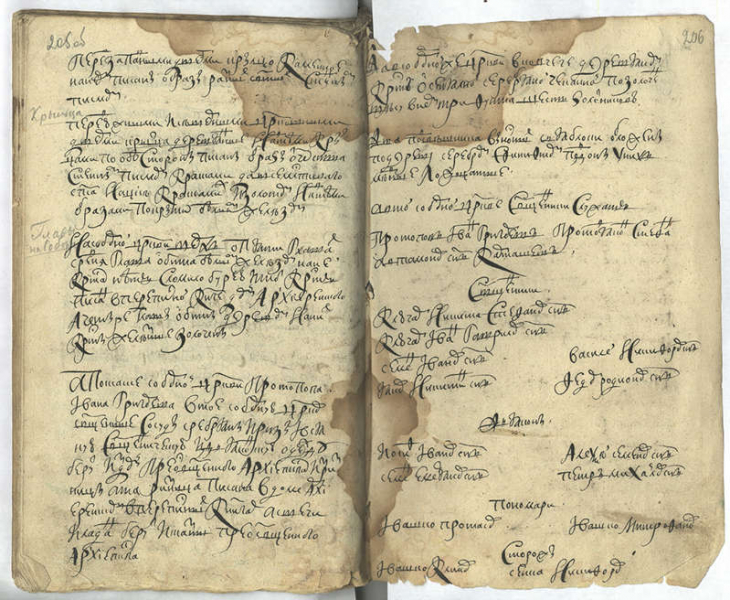
Inventory of the treasury, buildings and property of the Vologda bishop's house of St. Sophia 1701 Original.
The idea of church reform, which radically changed the position of the clergy in the state, came to Peter I during his trips to the White Sea. This conclusion was made by historians after studying the materials of the North Russian dioceses of the 1690-1700s. Scientists have shown the importance of using regional archives in solving all-Russian historical problems. The results of the study, supported by a grant from the Presidential Program of the Russian Science Foundation (RSF), are published in the journal Canadian-American Slavic Studies.
The beginning of the contradictions between the Russian Orthodox Church and the state dates back to 1503, when Ivan III at the council proposed “to all the rulers and all the monasteries of the village to unite and all to their own” – that is, to take the church lands in favor of the state. However, until the 18th century, the Church did not actually submit to the state, owned huge land holdings and serfs, and even had judicial privileges. The turning point came in 1701-1722, when Peter I carried out a set of measures to reduce the influence of the Church and reduce its independence from the secular authorities. Nevertheless, until now, not much was known about the origins and prehistory of the church reform of Peter the Great.
Scientists from the St. Petersburg Institute of History of the Russian Academy of Sciences and the Vologda State University studied the archival materials of two dioceses of Northern Russia: Vologda-Belozersk and Ustyug-Totem. They uncovered a list of documents that reflected the office work of the “congresses” of the monastic affairs in Vologda, Ustyug and Kirillov in 1701-1705. It was these courtyards that were the “driving mechanisms” of the initial stage of the church reform. The “congresses” were led by stewards sent from the Monastic Prikaz (the highest judicial body for the clergy). They compiled inventories of buildings and property of monasteries, bishops' houses, city cathedral and rural parish churches. It turned out that during this large-scale revision there was a “meeting of the old and the new”: the boyars, clerks and stewards used traditional forms of compiling inventories of buildings and property, officially enshrined in 1551. At the same time, “Sheets” appeared, which became the most widespread type of mass documentation in the 18th – 19th centuries. They resembled questionnaires: before drawing up a document, in the order they made a list of questions, to which they then received answers on the spot and wrote them down.
“We have shown that the church reform of Peter I began not after the death of Patriarch Adrian and the ban on the election of a new patriarch in 1700, but, in fact, in the 1690s. The transformations did not mean a sharp break with the past, although they turned out to be a turning point in church-state relations. When organizing and carrying out the first stage of the reform, the tsar and the officials of the Monastic Order used quite traditional instruments of control over church property and values. However, earlier, when compiling scribes and census books, church estates were described simultaneously with landlord and state lands. At the beginning of the 1700s, the described lands were allocated on the basis of their belonging to the Church. When making descriptions, Peter's officials, as in the 17th century, ate, traveled and received paper and ink from churches, monasteries and bishops' departments, as well as in their estates, ”said Nikita Bashnin, head of the RSF grant, Ph.D. Laureate of the President's Prize in Science and Innovation for Young Scientists, Senior Researcher at the St. Petersburg Institute of History of the Russian Academy of Sciences.
At the initial stage, the goal was to accurately establish the amount of financial and human resources of the Church, for which census work was carried out in a short time. The novelty of the church reform was in how Peter I and the Monastic Order took advantage of the results. According to scientists, the realization that the Church possesses significant land, industrial, financial and human resources came to Peter I during his trips to the White Sea (he drove past the Rostov and Vologda bishops' houses, visited Veliky Ustyug and Kholmogory). Discussion of this issue with the officials of the order of the Grand Palace and his employees strengthened the king in the idea of using these resources for state interests. The dramatic defeat for Russia at the beginning of the Northern War motivated Peter I to take active steps, and the experience of describing the northern dioceses in 1701 was extended to the entire country. In previous centuries, an inventory of buildings, property and estates was sometimes carried out by tsarist decree and necessarily when changing church officials in the interests of intra-church control over property. Now these documents were drawn up only for the state.
Peter I, knowing and understanding the material component of the episcopal power, received an instrument of influence on the clergy. If at the end of the 17th century. the bishops had their own armed detachments (boyar children), and the hierarchical power was often opposed to the power of the voivode, then in the 18th century the bishops' courts “dissolve”, and the spiritual power is increasingly subordinated to the secular power. The successful initial stage of church reform in 1696-1703, its important socio-economic component – all this probably played a role in the subsequent reform of the Church and its inclusion in the apparatus of the absolutist state.
Read also:
Project 5-100 is dead, long live Priority 2030?
New nomenclature of scientific specialties approved
Cell culture, vaccine ethics
Interrupted connection to the server
First COVID-19 drug in pill form developed

